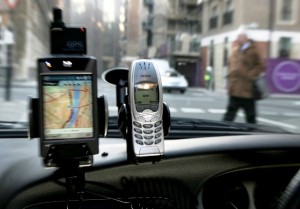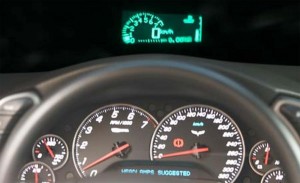
Automakers are turning to high-tech solutions to address both high- and low-tech distracted driving issues.
In an era where everything from text messages to sliding briefcases to spilled coffee and crying babies can distract a driver, one of the biggest jobs of automotive engineers is to help find a way to to keep a motorist’s attention focused on the road.
With federal safety regulators estimating that more than one in 10 U.S. highway fatalities results from distracted driving, many states are beginning to crack down with laws that limit the use of hand-held cellphones and texting while behind the wheel. But there’s a growing interest in using high-technology solutions to battle against distracted driving.
Carmakers are deploying a variety of strategies, including the wider use of voice commands that will allow a driver to change stations or request directions to a specific location. Head-up displays that put information, such as vehicle speed, on the windshield are also becoming more common. HUD is available on a number of high-line products, including the 2014 Chevrolet Corvette, and at the other extreme, on the new Mazda3, while Mini plans to roll the technology out on a wide range of models.

Head-Up Display technology, like this system on the 2014 Corvette, aims to keep a driver's eyes focused on the road.
And the technology world is weighing in. The latest update to Microsoft’s Windows Phone software introduces a new Driving Mode that will silence incoming calls and texts to let a driver focus on the road. It can be set to automatically activate when a Windows smartphone is connected to a car’s Bluetooth audio system. Apple, meanwhile, has a Do Not Disturb function for the iPhone – but it must be activated manually.
(New Ford, Toyota systems can steer a car around pedestrians, double-parked cars. Click Here for more.)
Ford is one of several major manufacturers studying the impact of distracted driving – the Detroit automaker using a simulator nearly identical to those used by airlines to train their pilots, but in this case designed to detect what happens when a “driver” tries to text or do seemingly simple tasks like changing a radio station or checking navigation directions.
But carmakers are increasingly turning to their suppliers for breakthrough technology to reduce the problem of distracted driving.
Delphi, for example, has developed systems to mitigate distractions by placing all important information in the driver’s field of view, with the ability to control all major functions by the touch of a button on the steering wheel or by voice recognition. Helping the driver keep “eyes forward” is a high-mount, transparent display with reconfigurable clusters that keeps critical data in the driver’s line of view at all times according to Jeffrey J. Owens, Delphi’s chief technology officer.
(New IIHS study rates forward collision avoidance systems. Click Here for the seven best.)
Google, which is already working on autonomous technology, is developing a new gesture control system that would not require a motorist to actually find a specific button. It could simply respond to specific types of gestures to, for example, change a radio station or adjust the volume. Cadillac had help from its technology partner developing the new CUE infotainment system, meanwhile, which uses a proximity sensor to know when the driver is reaching for the touch screen, adding additional features, such as the ability to zoom in or out. Otherwise, much of the normal clutter is left off the display.
Bosch, another major supplier, has developed a system that works during monotonous driving situations, such as long expressway trips, which can lead to loss of concentration. Based on steering-angle data, the Bosch Driver Drowsiness Detection system continuously analyzes the steering by the driver to identify phases during which the driver does not steer for a brief period and then makes an abrupt correction – often a sign of failing concentration and arising tiredness.
(Highway deaths dip after unexpected 2012 rise. Click Herefor details.)
The function combines the frequency and strength of these reactions with other data such as vehicle speed, time of day and other indicators to calculate a tiredness index. If this index exceeds a specific value, a visual and/or audible signal can warn the driver of the danger of nodding off at the wheel.
Several distracted driving systems are already in use on products such as the Mercedes-Benz S-Class and Lexus LS, the latter model adding a camera to watch for visual cues that the driver is growing drowsy.
Continental AG, another major supplier, is also working to reduce the dangers of distracted driving, which, a senior executive notes, is responsible for the death of 10 people and the injury of 1,100 more every day, according to data from the U.S. Department of Transportation.
Human error, on a broader scale, is a factor in about 80% of traffic accidents, according to Zak Bolton, a Continental project engineer. The reasons are complex and range from driver drowsiness and monotonous driving situations to increased stress and driver information overload, he said.
Continental has enlisted advanced driver assistance systems, active safety technology using interior monitoring, and visual “Human-Machine Interface” technology to constantly scan both the vehicle’s external and internal environments. The technology works to make sure the driver’s actions and attentiveness match the real time needs of the driving situation through the use of an infrared driver analyzer positioned in the vehicle’s steering column.
Like the camera in the Lexus, it studies a driver’s facial behavior — such as eye and head movements – to sense whether a driver is drowsy or has his head turned away from the road in a critical situation. For example, if the system detects that a driver is looking away from the road while approaching a potential traffic hazard– the “Halo” will be activated, creating a light trail that brings the driver’s eyes back to the road.
Continental is also experimenting with an infotainment system that intuits by various cues what the driver might want to do and then put the appropriate controls on the car’s touchscreen.
“People look at the car today and say it hasn’t changed much in recent years,” Bolton said. But underneath, it really has,” he said.
Such technologies can go a long way towards keeping the driver’s eyes focused on the road, proponents contend. Along with other active safety systems that can watch for obstacles, steer around pedestrians and even apply the brakes in an emergency, another senior Continental executive, engineering systems director Steffen Linkenbach, recently suggested that the industry now is forming “a clear vision of accident-free driving.”
Whether that vision can become a reality remains to be seen, but simply helping reduce distracted driving could have a major impact.
Paul A. Eisenstein contributed to this report.

Unfortunately studies have already proven that voice command devices do not reduce driver distraction. It may increase the problem as braindead drivers think they can multi-task while driving by using voice commands. All you need to do is observe people driving with these devices to confirm the problem.
Jorge is right. Voice command doesn’t really decrease the mental task load
Would any of this proposed new technology have kept Nate Burleson from crashing when he leaned over to grab his sliding pizza box?